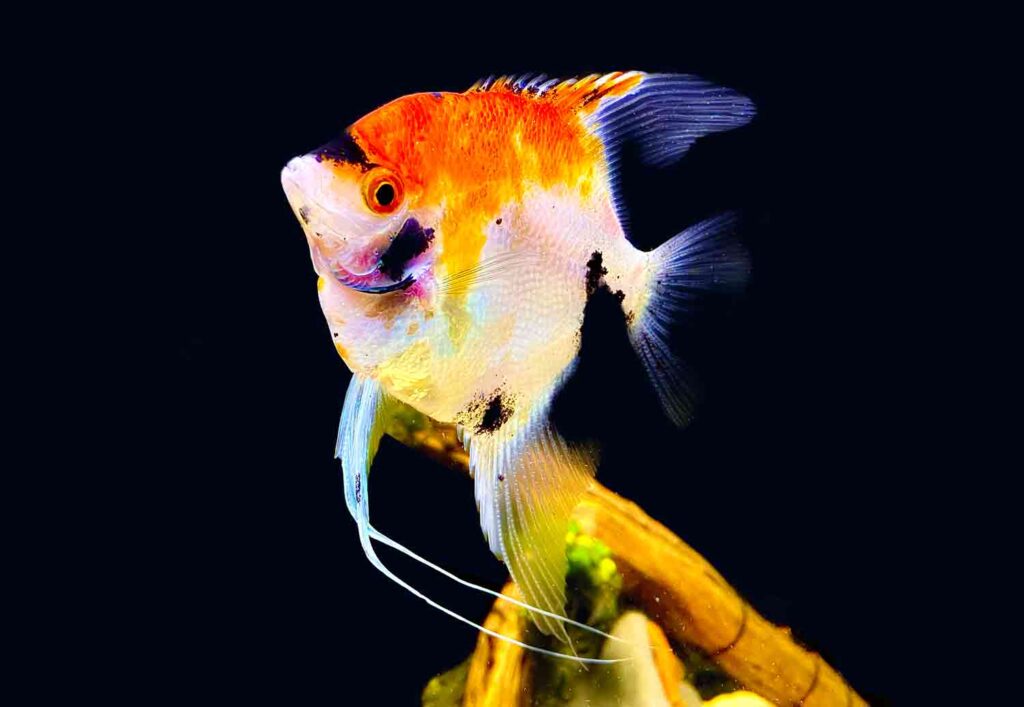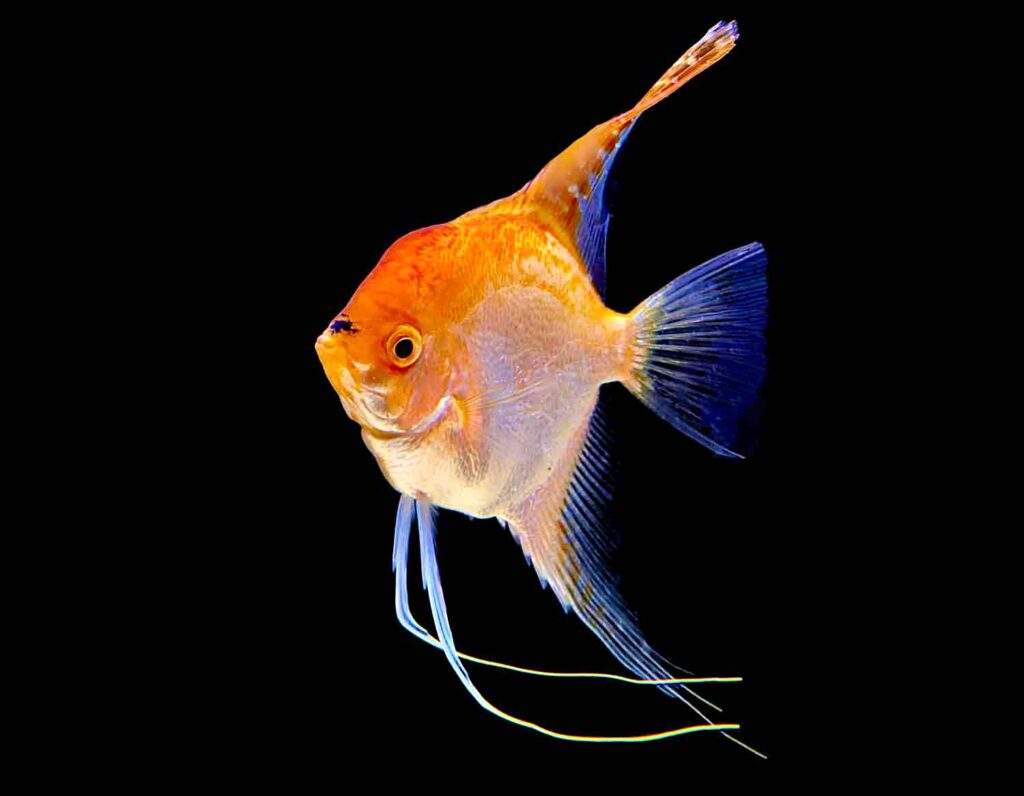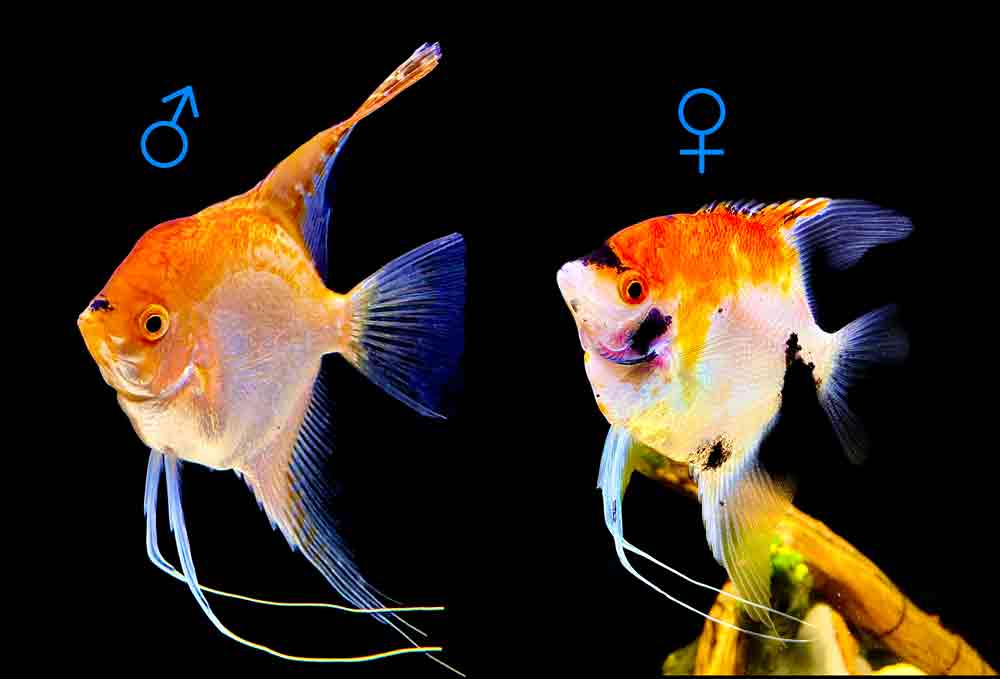Angelfish (Pterophyllum) is one of the most beautiful and most kept aquarium fish available in the hobby. Its unique appearance and size make it a perfect fit for most tank sizes. After years of line breeding these fish, we now have many different color patterns available in the market.
In this article, You will find all the information you need about freshwater Angelfish.
Freshwater Angelfish Overview
Angelfish is a freshwater fish belonging to the Cichlidae family native to the Amazon River in South America. Angelfish are popular aquarium fish for their unique arrowhead body shape and long flowing fins.
Like all cichlids, Angelfish will prey upon small fish in the tank and will fight over territory in the tank. They tend to be compatible with most small predatory and even some smaller tropical fish. This makes them a great fish for community tanks and will make a great addition to any aquarium. They are easy to care for and can live in most water parameters in aquariums.
In the wild, Angelfish fish are found in slow-moving streams and rivers where water is warm and slightly acidic. The fish’s natural habitat is filled with driftwood, fallen trees, and live plants that they can scavenge for small fish to prey on.
In Aquarium, you will need to add driftwood, plants, and rocks to mimic their natural habitat. This will make them feel safe and calm them down.
Appearance

Angelfish look similar to an arrowhead and have long beautiful fins. They have compressed but round bodies with triangular dorsal and anal fins. Fins are long and stretched, which makes these fish very beautiful. In the wild, their body shape helps them to hide, among roots and plants, from predatory larger fish. Angelfish are semi-peaceful fish with occasional aggressive tendencies, especially in the breeding season.
The wild varieties are usually striped with dull colors to camouflage in rivers. The captive-bred varieties are line bred to create different colors and more beautiful fin shapes.
Like all fish, they are more colorful and vibrant when they are not under stress. They might lose color when water parameters or tank setup is not in their favor. This is more visible in wild-caught angelfish that are not well adapted to aquarium environments.
Angelfish size:
Angelfish will only grow to 6 inches (15 cm) in height (including the fins) and about 3 – 4 inches in body size.
This makes them an ideal fish for most medium and large tank sizes and you will not have to worry about the fish outgrowing your tank. Female angelfish have smaller bodies compared to males.
Lifespan
Under the right conditions, Angelfish lifespan is about 10-12 years. A bad diet, low water quality, and stress will reduce the life expectancy of this beautiful fish.
Behavior & Temperament
Angelfish are active and semi-peaceful fish that don’t mind living with other cichlids or other fish types. They prefer to swim around the tank without causing any trouble for other plants of the same-size fish. These fish are more active during the day than at night.
They are omnivore fish with a tendency to eat more meaty foods. They will eat any small fish or shrimp that fits in their mouth. They are also ambush predators and will hunt small fish that might not even fit in their mouths. So it’s important to not put any small peaceful fish with these guys.
Angelfish are territorial and will fight with other angelfish or other types of fish over territory. This behavior is more noticeable once they pair up and start to breed. To reduce territorial behaviors you should first avoid adding too many fish and move tank decoration around from time to time.
Angelfish care:
Angelfish prefer to live in well-aerated tropical water with slow water flow. It is best to set up your aquarium as close to what it gets in nature as possible. To make this happen, you should place lots of plants, driftwood, and rocks in your tank.
Angelfish are very hardy fish and will adapt to all kinds of water parameters. This makes them one of the best beginner fish. Most beginner fishkeepers buy these fish for the beautiful appearance and colors they have. Without thinking about the tank parameters they need to thrive.
These fish need a diet that consists of meaty food as well as small amounts of algae and vegetables. When you provide them with clean water and a balanced diet they will grow healthier and will live longer.
Overall, this is an easy-to-care fish and can tolerate a wide range of water parameters.
Tank size:
The minimum tank size for a small group of Angelfish fish is 20 gallons tall or 30 gallons regular aquarium. These fish will grow very fast and are tall fish so they will need more vertical swimming area. The larger your aquarium is, the better environment you can create for this fish. The recommended tank size is only for a single fish! More than one or two fish will need a larger aquarium.
If you have a big aquarium, you can house multiple angelfish. When they live in larger groups, they might show some schooling behavior. Larger groups will make the fish feel safe and will reduce stress levels. This means your fish will live longer and will live a healthier life. But keep in mind not to overcrowd the tank or they will start to fight with each other.
Tank Setup:
These fish are not so fussy and will adapt to any tank setup as long as the water parameters are in their favor. You’ll find your Angelfish thrive when you mimic its natural environment where they get a lot of driftwoods, plants, rocks and sandy substrate.
Driftwood and rocks will provide hiding spots for the fish and make them feel safe and will reduce their stress levels. Angelfish are fast swimmers and might hurt themselves if there is sharp driftwood or rock in the tank. Make sure to select decorations that don’t have sharp edges.
Angelfish are omnivore fish and despite being a type of “Cichlid” they will not cause any harm to live plants. Adding live plants will provide beauty to your tank and these fish will enjoy swimming around and hiding in the plants. Plants will make your fish feel less stressed.

Filtration:
Angelfish need clean water, so a good well established tank is recommended. When filtration of your tank can’t keep the water in pristine conditions it will cause health issues for this fish. Your fish might get internal or external infections or diseases, or even die.
These fish like to have a slow current in the rank so you will need to buy a filter that is not too strong. A simple sponge filter is the ideal filtration system for them. Tho most might not like the appearance of the sponge filter. You can also use hang-on back filters or canister filters that do not create lots of current.
A hang-on back filter or canister filter is the best option if you control the flow.
Water Parameters:
These fish enjoy well-oxygenated tropical temperature water with a slow current in the tank. An air stone bubbler is highly recommended to increase the oxygen levels in the water.
Avoid fluctuating parameters in the tank as constant water parameters are the key to the health of Angelfish. The following is the range this fish can handle.
- Water temperature: 75°F – 82°F
- pH levels: 6.5 to 7.5
- Water hardness: 4–12 dGH
Angelfish Diseases & Prevention:
Angelfish are hardy fish and do not get sick very easily. When water parameters are not in favor of this fish or they are under stress they tend to get sick. They are also susceptible to all common aquarium diseases that other fish might carry.
Prevention is the best cure! Remind yourself to clean the tank regularly and keep an eye on the water parameters. Never add new fish to your tank without properly quarantining them. Regular water changes and good food will prevent many of the diseases aquarium fish might get.
Diet and Feeding Requirements
Angelfish are Omnivore that will mainly eat meaty foods but will also eat algae, plant matter, fresh vegetables, and small microorganisms. Meaty foods are the main part of their diet. You should feed them with prep food, small crustaceans, and insect larvae.
Angelfish prefer live foods over prepared food. This will sharpen their natural hunting behaviors. You can feed your fish live foods such as bloodworms, brine shrimp, and other available live food. If live options of this food are not available you can feed them frozen versions that are available in most pet stores and online.
There are also many commercially prepared foods available that have good nutritional value. When feeding prepared foods, always feed your fish in multiple different types. High-protein fish flakes or pellets mixed with a low amount of high-fiber plant food are a good mix to feed.
You can also feed fresh zucchini, cucumber, and other fresh vegetables. Simply cut the vegetables and place them somewhere in the tank. Do not keep fresh vegetables like cucumber in the tank for more than 12-24 hours as they will start to decay and will make your aquarium dirty.
Gender Differences

Males and females Angelfish look very similar and are almost identical. Both genders are almost the same size and can have the same color and patterns.
Females are slightly smaller and less bold than males. This is more obvious when both fish are mature. Males have a slightly bigger bump on their heads.
Fish behavior is also another way to identify males and females. Mature males are usually more territorial and will swim around the female to protect her from other fish and males. When two fish are swimming closely and show signs that they are paired then the bigger one is more likely to be a male.
The best way to get males and females is by buying a group of small angelfish and let them grow and naturally pair with each other. When selecting your fish in the pet store, buy some of the large ones and some of the small ones. This will give you a good chance of getting an even number of males and females.
Breeding And Reproduction:
Breeding Angelfish is very easy and can be done in an aquarium environment. Angelfish reach sexual maturity at about 6 – 12 months old. Once you see your fish are paired up you will need to separate them and give them their own tank to lay eggs and raise their fry.
These fish breed on flat vertical surfaces, so make sure to add a slate or a tile standing upright in the tank. When a female is ready to lay eggs, she will start to lay eggs on the surface you provided and the male will swim after her and fertilize the eggs she just laid.
They will lay about 100-1200 eggs each time. The younger fish will lay low quantities while aged fish will lay more eggs.
After about 4 – 5 days eggs will hatch but will stay attached to the tile for a few more days before they start to freely swim in the tank. You will only need to feed the fry after they start to swim freely in the tank. Hatching brine shrimp is the best way to feed the fry.
In order to breed and raise Angelfish successfully, you will need to follow the recommendations we made in the “Care ” section of this article. Doing this will give you a good ground in breeding them naturally in your tank.
Providing good high-protein foods and large water changes will trigger the fish to spawn. High protein foods will help the females to develop more eggs and breed faster.
Angelfish Tank Mates
Angelfish are semi-aggressive fish and will fight over territory in their breeding season. However, under the right conditions, they can live with any peaceful or aggressive fish of approximately the same size or smaller.
Angelfish personalities are very different from fish to fish. Some are very aggressive and some are not at all. Most Wild-caught angels are very aggressive and will bully your fish to death. Captive-bred angels are calmer and can live with smaller fish in a community tank.
Here are some of the compatible:
- Discus fish
- Gouramies
- Clown Loach
- Rainbow Shark
- Congo Tetra
- Mollies
- Mystery snails
- Plecos
- Bala shark
Are Angelfish Right for You?
In a single species tank, they can live in a 20 gallons tall aquarium. If you have a community tank with other fish in it, then a 30-gallon or bigger aquarium is needed. If you have a smaller aquarium that is already filled with other fish then Angelfish are not the fish you want to bring home. Angelfish are usually kept in groups so a bigger tank is always recommended.
If you have a tank with small fish like rasbora, neon tetra, or shrimps then this fish is not an ideal fish for you. Angelfish will prey on smaller fish and invertebrates.
If you have none of the above restrictions in your tank then angelfish can be a great fish that you will enjoy having for a long time.

Conclusion
Angelfish is a type of South American cichlid that looks beautiful and will not outgrow your tank. They are easy to keep, and breed, and do not require a lot of maintenance. Their relatively peaceful nature makes them one of the best cichlids to keep in a community tank.
If you have any questions or need more help please reach out to us on social media or via our contact us page. We would love to hear from you.
We also answered some of the most common questions asked about these fish on another page. You can find them here: Commonly Asked Angelfish Questions